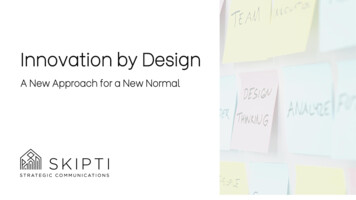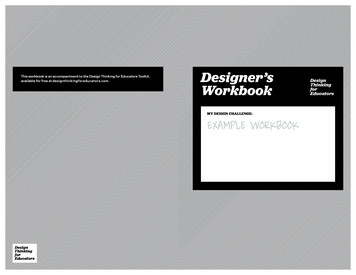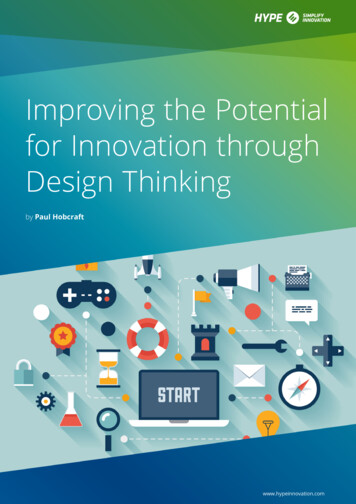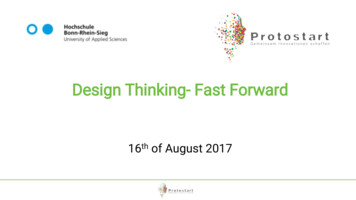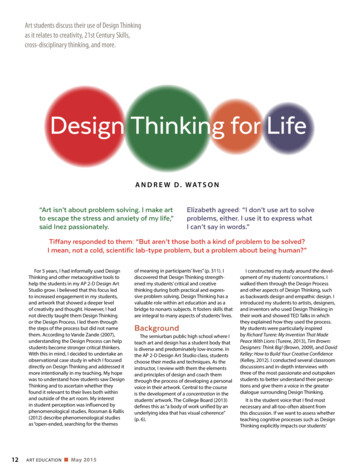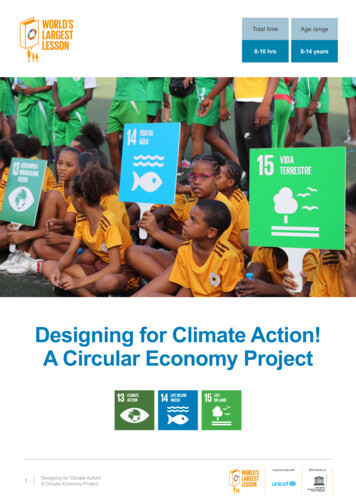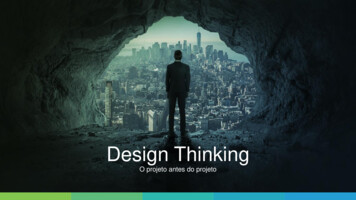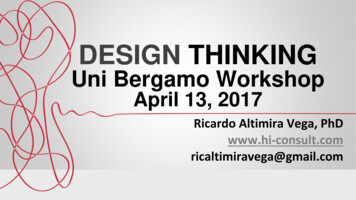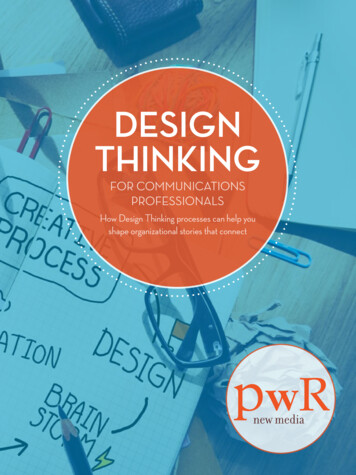
Transcription
DESIGNTHINKINGFOR COMMUNICATIONSPROFESSIONALSHow Design Thinking processes can help youshape organizational stories that connect
1What isDesign Thinking?“Design Thinking is a state of mind.It’s a human-centric, holistic approach to problem solvingand business thinking that employs empathy, ideation,prototyping and experimentation to solve real-world issues. Fororganizations seeped in this approach, Design Thinking workshorizontally across an organization to tear down silos, improvecommunications, and deliver new insights. It’s been called“the search for a magical balance between business and art;structure and chaos; intuition and logic; concept and execution;playfulness and formality; and control and empowerment.”1 It’sbeen called “the glue between disciplines.”2Here are a few things to love about Design Thinking: It insists business people keep focused on humans andhuman needs. It relies on both creativity and logic. It promotes a learn-by-doing approach and even suggeststhat failure is a good way to learn. It’s crazy collaborative. And, it posits that the way a thing looks is not a secondaryconsideration; rather, things cannot function well if theydon’t appeal to our hardwired visual senses.Oh, and did we mention it’s a process?The five-step Design Thinking process creates a collaborativeand adaptable framework for problem solving—the frameworkitself is where the magical balance resides.The illiterate ofthe 21st century willnot be those whocannot read and write,but those who cannotlearn, unlearn,and relearn.– Alvin TofflerDesign is notjust what it looks likeand it feels like. Designis how it works.– Steve Jobs[1] Idris Moottee, Design Thinking for Strategic Innovation (2013), p. 32.[2] Arne Von Oosterom, thinking-is-glue-between-disciplines
2Design Thinkingin five stepsThe Design Thinking process is aimed at codifyingthe artistic or scientific way of thinking.The steps are:1.UNDERSTANDING & EMPATHY — This is where you learnas much as you can about your audience.2.DEFINING THE PROBLEM — This is where youinvestigate myriad aspects of given problems anddevelop personas based on demographics, goalsand objectives.3.4.5.Did we mention it’s iterative?Design Thinking is iterative, which meansyou test assumptions then return to theprototype stage and modify it based onresults and feedback. Iterate to learnlessons, sooner rather than later,then try again.BRAINSTORMING SOLUTIONS — Often calledthe “ideation” phase, a bunch of ideas are tossedout while judgment is suspended and creativity isencouraged.PROTOTYPING SOLUTIONS — Here you’re tryingto quickly, and affordably, test your assumptionsabout people, materials and processes.TESTING THE SOLUTION — Learn what works andwhat doesn’t so you can tweak to enhance.”Design thinking isneither art nor sciencenor religion. It is thecapacity, ultimately, forintegrative thinking.– Tim Brown
310 Principlesof Design ThinkingDesign Thinking.1.2.3.4.5.6.7.8.9.10.Is action-orientedSupports changeFocuses on the humanDevelops foresightIs dynamic and iterativePromotes empathyReduces risksCreates shared meaningRelies on an adaptable processCombines logic and creativityDesign Thinkina get-your-hang proposesdlearning-by-dos-dirty,ingapproach.Design Thinking promotesa focus on end-user’s needs;thus, Design Thinking processesemploy employ listening-basedtechniques to better unearthboth acknowledged andunacknowledged needs.Design Tare iterat hinking procesand grow ive, always chan sesis evolvin ing because the gingany high g faster and faste worldmust be performing app r andradaptable and nimoachble.
What doDesign ThinkingSolutionslook like?4“Growth needsa strategy, andevery strategyneeds a story.”– Idris MootteeDesign Thinking solutions can be matchedto specific business challenges.Storytelling can solve evenhigh-tech problemsSo for example.Business ChallengeDesign Thinking ionRelevanceValue RedefinitionLet’s zoom in on storytelling.It is our topic after all! And you might beasking yourself how telling a good brandstory leads to organizational growth?Growth requires creating a clear, consistentvision of the future. Growth can, ofcourse, be measured by many differentyardsticks. The most meaningful yardstickis the one that shows progress with respect to an organization’sstated goals, whatever they are. Goals, by their very nature, arefuturistic. And storytelling can paint a compelling and authenticpicture of the future that gets audiences to see a desired ending.[3] https://www.youtube.com/watch?v jajduxPD6H4Doug Dietz, head designer for GEhealthcare, learned that thecutting-edge MRI and CT machineshe designed terrified kids. So he usedDesign Thinking processes, workingwith parents, children and hospitalstaff to brainstorm solutions. Dougsolved the problem by adding visualstorytelling elements to the machinesand scan rooms, turning them intokid-friendly adventures: pirate ships,submarines, campsite, underwaterscenes and more. The “adventureseries” scanners have been a hit,putting the human element back inthe process—a truly meaningful movefor GE healthcareand the patientsthey serve.3
Why isbrand storytellingso important?5“If history weretaught in theform of stories, itwould never beforgotten.”– Rudyard KiplingStories not only paint plausible visions of the future, they alsocreated shared meanings and grow human connections.And stories are a great way for brand storytellers to shapeand share a company’s true values and purposes. If told well,a story will embody a company’s beliefs and personality butin a way that is entertaining and memorable for the audience.And stories are remarkably durable strategies and tactics canbe disrupted by competitors, shifts in industry, and just badluck, but stories are impervious to these outside forces.When you get right down to it, we humans don’t live ourlives in jargon or in bullet points. So jargon and bulletpoints don’t really sell a story or a product or a service.We live our lives in color and narrative!Well-told stories evoke emotions. And emotions triggerdopamine (logic doesn’t). Dopamine is like a sticky for thebrain — a sticky that tells our minds: “Remember this.This matters!”is.Remember thThis matters!“I’ve learned that peoplewill forget what you said,people will forget whatyou did, but people willnever forget how youmade them feel.– Maya Angelou”“In a world when being strategic means being logical andfact-based, where do stories belong? They add an emotional dimension tobusiness logic. They foster empathy and connectedness. They prioritizeinformation and objectives and they evoke our hardwired predispositionto process information faster and more holistically when presented to usin the form of a good story.”4[4] Idris Moottee, Design Thinking for Strategic Innovation (2013), pp. 86-87.
6Why should youcare aboutDesign Thinking?Communications professionals should careabout Design Thinking because you are thestorytellers.Using storytelling for better brand communications is hardlya new idea—many communications professionals, perhapseven you, have been doing this for a long time because youunderstand that telling your brand story as a narrative makesyour brand more coherent and easier to connect with.emotionally!Design Thinking frameworks and processes can help youachieve this. They’re designed to shift the emphasis back to thehuman need for connectivity and meaning, back to empathy,exchange, participation, collaboration and understanding.And the Design Thinking approach provides specific tools forcrafting stories that stick.Now let’s take a look at six Design Thinkinginspired tips for telling a great story “We spend a lot of timedesigning the bridge, butnot enough time thinkingabout the people whoare crossing it.– Dr. Prabhjog SinghThose who tellthe storiesrule society.– Plato
7Tip One:Make itCollaborativeHere’s how a Design Thinkingcollaborative writing process might look:1.First, you empathize by putting yourself in your audience’splace. Use various listening techniques to betterunderstand your audience and try imagining it’s the firsttime they’ve ever heard of your organization and thesolution you offer to their problem.2. Then, you define the problem and brainstorm audienceneeds, touchpoints and emotional journey.EMPATHIZEDEFINE3. Create as many potential stories as possible, as quickly aspossible, with as many stakeholders as you can engage.4. Remember, there’s no such thing as a bad idea whenbrainstorming.BRAINSTORM5. Take the best idea and refine it using a classic story arc.Share the draft widely and incorporate feedback for polish.Voila! You’re on your way to blockbuster brand story!PROTOTYPEGreat things aredone by a series ofsmall things broughttogether.– Vincent Van GoghTEST
Tip Two:Make itHuman8“The shortestdistance betweena human being andtruth is a story.”– Anthony De MelloCrafting and sharing organizational narratives and messagesthat drive business goals is a whole lot easier when you getback to the basics of human needs and human problems.Why? Because when you get right down to it, whoever youraudience is—journalists, bloggers, influencers, consumers, theC-suite, employees, even search engines—ultimately you’retrying to communicate and connect with people. (Not a lotof consumer blogging robots around yet!) And people arefascinated by people, by human challenges and pain and joyand triumph.So putting people--real or imagined human protagonists thatyour audience can identify with--at the center of your brandstories is just more effective.Data is nosubstitutefor intimacy.– Roger MartinCreating stories aboutreal people that will tugthe heart strings of youraudience starts with aclear understanding of youraudience and continueswith character and plotdevelopment that isauthentic and believableand delivered in a fresh,entertaining style.Pleaseunderstandme!
9Tip Three:Make itStructuredPeople understand stories that have a beginning, a middle andan end. Because we live our lives in narrative, employing thisfamiliar linear structure in brand stories makes it easier for youraudience to identify with your story’s challenges, relationshipsand solutions.Most organizational stories are true tales about how yourcompany’s product or service solved a problem for a customer,how you met a real need. (These used to be called case studies.)The goal of these brand stories is to establish credibility andconnection by casting your organization in the role of hero,rather than sloppy salesperson droning on and on about yourproducts or services in isolation. A hero tale trumps a sales pitchany day of the week because sharing and solving is good, butshilling is bad.Following a beginning-middle-end structure enables youto create an ending that explains how your product orservice solves real world problems—problems your audienceunderstands and solutions they want.Howthis willend?A good story must: Be about a specific person ora small group of people ratherthan a whole company. Draw out a basic humanemotion such as frustration,hope or excitement. Feature struggle and requirethe character to change orlearn something. Embrace details (these setone story apart from another).
Tip Four:Make itReal(ish)Many organizational stories feature real people, butsometimes your organizational stories aren’t updated casestudies, but rather, fictive accounts of fictive customersor other actors, which is perfectly fine as long as you’retransparent and not trying to fool your audience.“Fictiveness” refers to how true a story seems, howplausible it is.10Stories are more real(ish) when peppered with small detailsso don’t forget to add the little things that bring a story tolife: scenery, smells, sounds, and familiar object.Details should infuse your story with life at each point of the story arc, making it easier for your audienceto imagine your protagonist’s path from the beginning (the time the action starts), to the middle (whenyour protagonist faces a challenge and has an emotional reaction to it), to the end (when your protagonisttransforms and the problem is solved; thus giving meaning to the story).Here’s a typical movie plot we’ve all enjoyed a million times—a plot that followsthe established Hollywood story arc:FEELINGS:CONFLICT:Boy (and sometimes girl)is miserableBoy loses girlTRANSFORMATION:Boy changes andwins girl backMEANING:They live happilyever after aswell-suitedpartnersACTION:Boy meets girland falls in lovellywood Story AoHrcTheWhat you should know:This set up is more realish if it involves specificfacts and details, thesmall things like settingand background noiseand familiar object tobring the story to life.What you should know:The challenge is mostcompelling when itfocuses on human painand the unmet needsof the protagonist.What you should know:Sharing the emotionalstate and point of viewof main character/humans pulls youraudience in andmakes them feel moreconnected.What you should know:This is where you getto be the superheroand solve the problemby showing how yourresourceful solutionmakes life better forthe protagonist.What you should know:You want your audienceto have a “give me someof that” reaction, tobelieve their own life, orthe life of someone theyknow, would be betterif they adopted thesolution as well.A movie about a boy who met girl, fell in love and just got married without conflict wouldn’t be verycompelling! Why? Because it’s the change and transformation and pain of surmounting obstacles thatreally grabs us and tugs our heartstrings and helps us identify with the characters and the solutions.It’s the solution, the hero, that puts your organization in the role of problem-solver.
11Tip Five:Make itVisual & EngagingThe medium can make or break the message. Explore differentmediums for your story, imagining how it plays out acrossdifferent mediums and platforms.Stories that trigger all of our senses—sight, hearing, taste,touch, smell—can take your audience someplace new,someplace familiar but fresh. Visual storytelling tactics areparticularly essential in today’s visual world. A “Show, don’t tell”approach triggers an emotional response and also promotessharing, conversation and engagement of content by appealingto our hard-wired visual senses.99%of all sensory informationis filtered out by the brainimmediately.THAT MEANS ONLY 1%OF INFORMATION ACTUALLYGETS THROUGH!Here are some mediums to icsWebinarsAppsPodcastsSlideshowsEbooksEmploying diverse mediums turns your story into greatbranded content. And great content makes emotionalconnections (i.e., puts stickies right onto the brains of thepeople you want to connect with!). To create content of thiscaliber, you must understand your buyer’s journey. You mustunderstand context. You must understand a secret manymarketers don’t: A brand exists in peoples’ hearts, a brandexists in peoples’ guts, a brand never exists in a logo!Of the informationsuccessfully transmittedto the brain,90% IS VISUAL.In fact of the brain is devoted to visualfunctioning and, of course, our eyesare extensions of the brain.That’s probably why 65% of thepopulation are visual learners.
12Tip Six:Make itTangible &PerformativePeople like stuff they can see, touch and use in some way.Interactive is fun and tangible. So think about games orsimulations that enable an audience to experience a story in aself-guided fashion.And a performative story doesn’t just speak or write the words,it brings the story to life by leveraging dramatic techniques suchas body language, tone, voice, and timing. Matching tone, timing,voice and language to the platform is a must.For example, if you’re crafting When crafting a story fora brand story for video,text like blog posts andpay special attention to:whitepapers, consider:Eye ContactRhythm and PaceHand GesturesOrderFacial ExpressionsStyle and VoiceVolume and Tone of VoicePunctuation andGrammarPace and PausingReadability (use smallparagraphs and bullets)This doesn’t mean you lose the consistency of your brand—consistency is important for all relationships, personal andprofessional. But being consist doesn’t mean being boring. Forexample, any brand voice, for example—be it humorous orscientific or quirky or buttoned-up—can be adapted to differentmediums by playing with small details like order, rhythm, and pace.Great stories, especiallyif they’re interactive, cantrigger “neural coupling,”activating parts of thebrain that allows theaudience to turn the storyinto their own ideas andexperiences.When processing facts,two areas of the brain areactivated. But a well-toldstory can engage manyadditional areas, includingthe motor cortex, sensorycortex and frontal cortex.
And theCommunicationsProfessionals livedhappily ever after“Marketing is no longerabout the stuff that youmake, but about thestories you tell.”- Seth GodinHow does this translate into familiar dailytactics like websites & news releases?Our own littleDesign Thinking story Okay, so you’ve employed Design Thinking processes to craft afew great brand stories. Your stories are full of human warmth;they’re structured and real-ish; and you’ve even adapted storiesto different engaging and visual mediums like videos,whitepapers and slideshows. Your content is ready.Team PWR is particularly geekyabout news releases. Many yearsago, our founders used DesignThinking processes to reconsiderhow news releases are crafted andshared. Above all, we discovered thattraditional wire services were servingtechnology (they’re a wicked goodSEO tool) but no longer servinghumans: the journalists, bloggers,influencers and even consumers whouse releases.Now what? Amplification is another topic for anotherwhitepaper, but the short answer is: You amplify your messagevia various audience-appropriate platforms such as.EmailNewslettersWebsitesSocial MediaBlogsMicrositesNews ReleasesSEOBut remember, more is not always better. Not all brands need tocommunicate with target audiences across all platforms. Figureout what works for you (start by figuring out what platforms youraudience spends time on). Make sure your stories are transferableand sharable and send them out into the world. The stories thattug heartstring and add to our understanding of the world arethe stories that people want to share with their networks, thatjournalists want to pick up and write about, and that searchengines want to prioritize.Your brand rocks. You rock. And your stories can rock too.So start the process and feel free to reach out to team PWR ifyou need some help.In an effort to put humans back at thecenter of news release tactics, weresearched audience needs(read: we talked to an awful lot ofjournalists and bloggers to learn howthey want releases and what theywant in them) and went on to build abusiness by using great design, emailbest-practices, and, increasingly,media-friendly content to take newsreleases to the next level.The End(312) 924-4224 info@pwrnewmedia.comwww.pwrnewmedia.com13
Design Thinking in five steps The Design Thinking process is aimed at codifying the artistic or scientific way of thinking. The steps are: Design thinking is neither art nor science nor religion. It is the capacity, ultimately, for integrative thinking. – Tim Br
